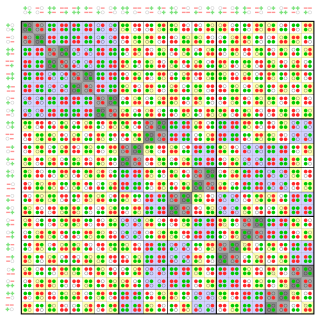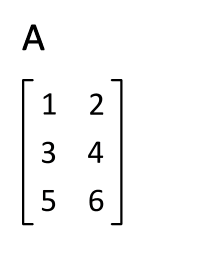In algebra and algebraic geometry, the spectrum of a commutative ring R, denoted by
, is the set of all prime ideals of R. It is commonly augmented with the Zariski topology and with a structure sheaf, turning it into a locally ringed space. A locally ringed space of this form is called an affine scheme.
In linear algebra, the trace of an n × n square matrix A is defined to be the sum of the elements on the main diagonal of A.

In mathematics, a ring is one of the fundamental algebraic structures used in abstract algebra. It consists of a set equipped with two binary operations that generalize the arithmetic operations of addition and multiplication. Through this generalization, theorems from arithmetic are extended to non-numerical objects such as polynomials, series, matrices and functions.
In mathematics, a formal power series is a generalization of a polynomial, where the number of terms is allowed to be infinite; this implies giving up the possibility of replacing the variable in the polynomial with an arbitrary number. Thus a formal power series differs from a polynomial in that it may have infinitely many terms, and differs from a power series, whose variables can take on numerical values. One way to view a formal power series is as an infinite ordered sequence of numbers. In this case, the powers of the variable are used only to indicate the order of the coefficients, so that the coefficient of
is the fifth term in the sequence. In combinatorics, formal power series provide representations of numerical sequences and of multisets, and for instance allow concise expressions for recursively defined sequences regardless of whether the recursion can be explicitly solved; this is known as the method of generating functions. More generally, formal power series can include series with any finite number of variables, and with coefficients in an arbitrary ring. Formal power series can be created from Taylor polynomials using formal moduli.

In mathematics, the special linear group SL(n, F) of degree n over a field F is the set of n × n matrices with determinant 1, with the group operations of ordinary matrix multiplication and matrix inversion. This is the normal subgroup of the general linear group given by the kernel of the determinant

In linear algebra, the transpose of a matrix is an operator which flips a matrix over its diagonal, that is it switches the row and column indices of the matrix by producing another matrix denoted as AT. It is achieved by any one of the following equivalent actions:

In mathematics, the name symplectic group can refer to two different, but closely related, collections of mathematical groups, denoted Sp(2n, F) and Sp(n). The latter is called the compact symplectic group. Many authors prefer slightly different notations, usually differing by factors of 2. The notation used here is consistent with the size of the matrices used to represent the groups. In Cartan's classification of the simple Lie algebras, the Lie algebra of the complex group Sp(2n, C) is denoted Cn, and Sp(n) is the compact real form of Sp(2n, C). Note that when we refer to the (compact) symplectic group it is implied that we are talking about the collection of (compact) symplectic groups, indexed by their dimension n.

In mathematics, the unitary group of degree n, denoted U(n), is the group of n × n unitary matrices, with the group operation of matrix multiplication. The unitary group is a subgroup of the general linear group GL(n, C). Hyperorthogonal group is an archaic name for the unitary group, especially over finite fields. For the group of unitary matrices with determinant 1, see Special unitary group.

In mathematics, the exterior product or wedge product of vectors is an algebraic construction used in geometry to study areas, volumes, and their higher-dimensional analogues. The exterior product of two vectors u and v, denoted by u ∧ v, is called a bivector and lives in a space called the exterior square, a vector space that is distinct from the original space of vectors. The magnitude of u ∧ v can be interpreted as the area of the parallelogram with sides u and v, which in three dimensions can also be computed using the cross product of the two vectors. Like the cross product, the exterior product is anticommutative, meaning that u ∧ v = −(v ∧ u) for all vectors u and v, but, unlike the cross product, the exterior product is associative. One way to visualize a bivector is as a family of parallelograms all lying in the same plane, having the same area, and with the same orientation—a choice of clockwise or counterclockwise.

In differential geometry, the holonomy of a connection on a smooth manifold is a general geometrical consequence of the curvature of the connection measuring the extent to which parallel transport around closed loops fails to preserve the geometrical data being transported. For flat connections, the associated holonomy is a type of monodromy and is an inherently global notion. For curved connections, holonomy has nontrivial local and global features.
In mathematics, the Bott periodicity theorem describes a periodicity in the homotopy groups of classical groups, discovered by Raoul Bott, which proved to be of foundational significance for much further research, in particular in K-theory of stable complex vector bundles, as well as the stable homotopy groups of spheres. Bott periodicity can be formulated in numerous ways, with the periodicity in question always appearing as a period-2 phenomenon, with respect to dimension, for the theory associated to the unitary group. See for example topological K-theory.
In mathematics, the spectrum of a C*-algebra or dual of a C*-algebra A, denoted Â, is the set of unitary equivalence classes of irreducible *-representations of A. A *-representation π of A on a Hilbert space H is irreducible if, and only if, there is no closed subspace K different from H and {0} which is invariant under all operators π(x) with x ∈ A. We implicitly assume that irreducible representation means non-null irreducible representation, thus excluding trivial representations on one-dimensional spaces. As explained below, the spectrum  is also naturally a topological space; this is similar to the notion of the spectrum of a ring.
In mathematics, specifically algebraic topology, the cohomology ring of a topological space X is a ring formed from the cohomology groups of X together with the cup product serving as the ring multiplication. Here 'cohomology' is usually understood as singular cohomology, but the ring structure is also present in other theories such as de Rham cohomology. It is also functorial: for a continuous mapping of spaces one obtains a ring homomorphism on cohomology rings, which is contravariant.
This is a glossary of properties and concepts in category theory in mathematics.
In mathematics, there are usually many different ways to construct a topological tensor product of two topological vector spaces. For Hilbert spaces or nuclear spaces there is a simple well-behaved theory of tensor products, but for general Banach spaces or locally convex topological vector spaces the theory is notoriously subtle.
Ganea's conjecture is a claim in algebraic topology, now disproved. It states that

In the mathematical field of Lie theory, there are two definitions of a compact Lie algebra. Extrinsically and topologically, a compact Lie algebra is the Lie algebra of a compact Lie group; this definition includes tori. Intrinsically and algebraically, a compact Lie algebra is a real Lie algebra whose Killing form is negative definite; this definition is more restrictive and excludes tori,. A compact Lie algebra can be seen as the smallest real form of a corresponding complex Lie algebra, namely the complexification.
A coherent algebra is an algebra of complex square matrices that is closed under ordinary matrix multiplication, Schur product, transposition, and contains both the identity matrix
and the all-ones matrix
.
In mathematics, the n-th symmetric power of an object X is the quotient of the n-fold product
by the permutation action of the symmetric group
.








